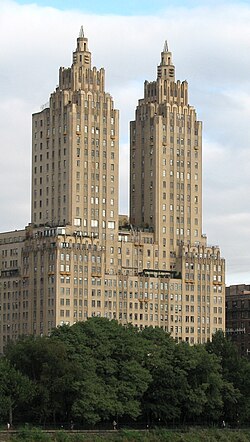| The El Dorado | |
|---|---|
 View from the southeast | |
 | |
| Alternative names | The Eldorado |
| General information | |
| Type | Housing cooperative |
| Architectural style | Art Deco |
| Address | 300 Central Park West |
| Town or city | Manhattan, New York |
| Country | United States |
| Coordinates | 40°47′18″N 73°58′03″W / 40.78833°N 73.96750°W |
| Construction started | 1929 |
| Completed | 1931–1932 |
| Height | 391 ft (119 m) |
| Technical details | |
| Structural system | Steel superstructure |
| Floor count | 29 |
| Design and construction | |
| Architect(s) | Emery Roth |
| Architecture firm | Margon & Holder |
| Main contractor | Elkay Builders Corp. |
The Eldorado | |
New York City Landmark No. 1521
| |
| Part of | Central Park West Historic District (ID82001189[1]) |
| NYCL No. | 1521 |
| Significant dates | |
| Designated CP | November 9, 1982[1] |
| Designated NYCL | July 9, 1985[2] |
The El Dorado (also spelled the Eldorado) is a cooperative apartment building at 300 Central Park West, between 90th and 91st Streets adjacent to Central Park, on the Upper West Side of Manhattan in New York City. It was constructed from 1929 to 1931 and was designed by architect of record Margon & Holder and consulting architect Emery Roth in the Art Deco style. The El Dorado consists of twin 12-story towers rising from a 17-story base. The building is a contributing property to the Central Park West Historic District, a National Register of Historic Places–listed district, and is a New York City designated landmark.
The base contains several small setbacks, and two towers rise from the eastern side of the base. On Central Park West, the first three stories are clad in cast stone, and the main entrance consists of three angular bronze archways. The remainder of the facade is made of tan and brown brick, which are arranged to emphasize the vertical lines of the facade. Some of the upper-story apartments contain angular stone balconies, and the tops of the towers are ornamented with sculpted finials. When the El Dorado opened, it contained 200 apartments with 1,500 rooms, though some apartments have since been split or combined. The main lobby is decorated in marble, and a gym in the building's two basement levels was added in the 1990s.
The El Dorado replaced a pair of apartments that were built in 1902 and also known as the El Dorado. The current apartment complex was constructed from 1929 to 1931 by developer Louis Klosk, who was unable to complete the building after the Wall Street Crash of 1929. The Central Park Plaza Corporation bought the El Dorado at a foreclosure auction in 1931. The corporation was taken over by the Pick Hotels Corporation in 1943, then by Hugh K. McGovern in January 1953. The building was then sold in May 1953 to pastor Charles M. "Daddy" Grace, whose estate sold the building in 1960 to Alexander Gross. The El Dorado became a housing cooperative in July 1982, and several parts of the building were upgraded, despite disagreement among tenants.
- ^ a b "National Register Information System". National Register of Historic Places. National Park Service. July 9, 2010.
- ^ Cite error: The named reference
NYCL p. 1was invoked but never defined (see the help page).